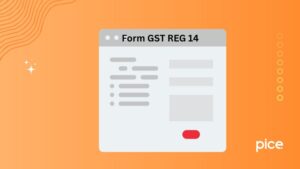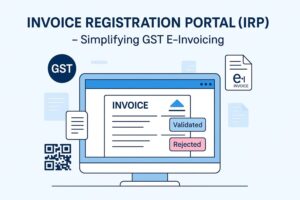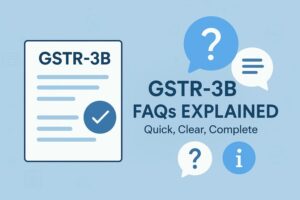What Is SGST, CGST, IGST and UTGST?
- 30 Aug 24
- 11 mins
What Is SGST, CGST, IGST and UTGST?
Key Takeaways
- GST Components: GST includes IGST, CGST, SGST, and UTGST, applicable under different scenarios like inter-state and intra-state transactions.
- IGST: Levied on inter-state transactions, IGST revenue is shared equally between central and state governments.
- SGST & CGST: Applicable on intra-state transactions, SGST revenue goes to the state government, while CGST goes to the central government.
- UTGST: Similar to SGST but for Union Territories, where revenue is collected by the UT government.
- Simplified Tax Filing: GST components eliminate multiple taxes, reduce costs, and streamline the tax filing process online.
To streamline the GST payment process for venture owners, the government has divided it into various components. These components of GST, also known as Goods and Services Tax, include SGST, CGST, IGST and UTGST. The venture owners have to pay for different GST components under different circumstances such as intrastate transactions or inter-state supplies. The blog highlights the difference between CGST, SGST, IGST and UTGST, such that you can easily understand the taxes payable under various scenarios.
Components of GST and Their Explanation
GST components are indirect taxes collected on the supply of various goods and services. There are 4 components of the GST. These are as follows:

- Integrated Goods and Services Tax or IGST
Integrated Goods and Services Tax (IGST) is levied on various interstate supplies of services as well as goods. The revenue that the government collects through this tax type is divided equally between the central and the state governments.
You should also note that it applies to all goods and services that are imported to or exported from India. Under IGST, you will also get to experience zero-rated exports, thus cutting down on costs.
For example, if a person in West Bengal sells a good of ₹1,00,000 at 18% IGST to a buyer residing in Jharkhand, he will have to pay ₹18,000 as GST for this inter-state transaction. This ₹18,000 is equally divided between the central and the state governments, that is, they get ₹9,000 each.
- State Goods and Services Tax or SGST
State Goods and Services Tax (SGST) is a tax that suppliers need to pay to the government for intrastate supply of goods and services. The entire tax amount is collected by the government of the state where the goods or services are sold.
After the introduction of SGST, various state taxes were merged under it. These taxes include entertainment tax, value-added tax, entry tax, luxury tax, etc. However, you must note that you can easily set off the SGST against IGST or SGST input tax credit.
Say suppose, you provide a good or service for ₹1,00,000 at 18% GST. In such a scenario, the total GST payable will be ₹18,000. In that case, the SGST deducted from that amount will be ₹9,000.
- Central Goods and Services Tax or CGST
Central Goods and Services Tax (CGST) is applicable for taxpayers who are involved in the intra-state transactions of services or goods. After the SGST is deducted from the applicable tax, the remaining amount will be treated as CGST.
- Union Territory Goods and Services Tax or UTGST
The Union Territory Goods and Services Tax is somewhat similar to SGST. Here, the government of the Union Territory is responsible for the collection of taxes upon intrastate supply of goods and services.
Usually, the Government of a Union Territory where the goods or services have been utilised can levy this GST type. Some of the union territories where UTGST is applicable include Andaman and Nicobar Islands, Ladakh, Chandigarh, Dadra & Nagar Haveli and Daman & Diu and Lakshadweep.
Objective of GST
The Government of India introduced GST with various financial objectives. These include:
- Increase in business compliance: The different laws under the GST Act ensure that the ventures comply and pay taxes on time.
- Reduction in prices of commodities: With various taxes merged into one, the overall tax to be paid reduces, minimising the cost of the product or services.
- Eliminate multiple taxation systems: Various taxes such as Value-Added tax, Destination-based Tax, Entertainment Tax, Purchase Tax, Service Tax, Central Excise Duty, etc. have been merged under GST.
- Increase the revenue of the country: With increased compliance with tax laws, venture owners pay taxes on time, increasing the revenue of the country.
- Enhances efficiency of tax filing: Since taxpayers only have to file one tax online, it greatly enhances the efficiency of tax filing. Additionally, it establishes a uniform tax structure, simplifying the process.
Why Is There a Split into SGST, CGST, IGST, and UTGST?
In India, the government has vested powers in the hands of the state and central governments to collect taxes during intrastate transactions or inter-state supplies. This step has not only simplified the tax collection process but also allowed both of these governments to generate adequate tax revenue through the collection of GST.
The SGST laws allow the state governments to collect taxes on intrastate movement of goods. This promotes fiscal economy within the state and ultimately across the country. Even, the CGST laws ensure that there is consistency in tax collection across the states. Finally, the IGST laws facilitate the interstate goods movement by providing a unified tax structure.
Furthermore, splitting the GST into CGST, SGST and IGST has several benefits. These include:
- Minimised effect of tax cascading: With the splitting of GST into different components, the “tax on tax” effect gets eliminated, increasing the efficiency of the overall tax structure.
- Simple to monitor tax collection: GST division makes it easier for the government to ensure that businesses comply with tax laws during intrastate as well as interstate transactions.
- Easy sharing of revenue collected: Both the centre and the state receive a fair share of the revenue generated from the GST collected, ensuring that they have enough money for administrative purposes.
- Improves business environment: The components of GST establish a common and predictable tax structure across different regions of India. This way it encourages a business-friendly climate across India.
What Determines If CGST, SGST, IGST and UTGST Are Applicable?
Although the state where the goods are produced and sold is important, the nature of the transaction is also vital to determine the applicable tax structure. It is essential for every business owner to understand when to pay which type of GST during the transaction of goods. Primarily, GST is applicable under two types of scenarios –
- Inter-state Transactions – When transferring goods from one state to the other, you will have to pay a single tax in the form of IGST. This saves you time as well as streamlines the tax-paying process during interstate supplies of goods and services.
- Intra-state Transactions – During the transaction of goods within the same state, you will have to pay CGST to the central government and SGST to the government of the state wherein you conduct the transaction.
To simplify the understanding of the type of GST that you will have to pay, all you can do is log in to the GST portal. Next type in the GSTIN of your venture to check the applicability of the GST component.
How Are Input Tax Credits Adjusted?

Input Tax Credit (ITC) helps in the reduction of the overall tax paid as GST. Some of the rules associated with it include:
- When paying IGST: First the IGST credit is used. After that, you can choose between SGST or CGST credit.
- When paying SGST: In the case of SGST, first the SGST credit is used and after that, the IGST credit will be used.
- When paying CGST: For CGST, at first the CGST credit will be used, following which the IGST credit will be used.
Difference Between CGST, SGST, IGST and UTGST
Listed below are some of the key points of differences between CGST, SGST, IGST and UTGST. These include:
| Features | IGST | CGST | SGST | UTGST |
| Applicability of Tax | Inter-state transactions of goods and services | Intra-state supply of goods and services | Intra-state supply of goods and services | Intra-union territory transactions of goods and services |
| Rate of Tax | Fixed by the GST council and combines the rate of CGST and SGST | Fixed by the central government and available at 0%, 5%, 12%, 18% & 28% | Fixed by the state government at slab rates of 0%, 5%, 12%, 18% & 28% | Applicable rate of UTGST is the same as that of the CGST. |
| Jurisdiction of Tax | Revenue goes to the central government | Revenue goes to the central government | Revenue goes to the state government | Revenue goes to the union territory government as well as the central government |
| Legislation of Tax | Governed by the Integrated GST Act the parliament passes | Governed by the Central GST Act the parliament passes | Governed by the State GST Act the state legislature passes | Governed by the Union Territory GST Act the parliament passes |
| Purpose of Tax | Replaces the previous inter-state taxes | Replaces multiple central taxes | Replaces multiple state taxes | It is a new tax for union territories |
| Collection of Tax | Collected by the respective state and central government | Collected by the central government | Collected by the respective state government | Collected by the respective union territory government |
| Example | A good manufactured in West Bengal and sold in Maharashtra | A good manufactured in West Bengal and sold in West Bengal | A good manufactured in West Bengal and sold in West Bengal | A good manufactured in Andaman and sold in Andaman |
How Are IGST, SGST, CGST and UTGST Collected?
There are different government bodies and agencies that aim to collect GST in different manners. These processes are as follows:
- State Goods and Services Tax (SGST) – SGST is applicable for intrastate supplies and the state government is responsible for collecting it. The GST-registered ventures collect taxes at the applicable GST rate from the customer and submit it to the respective state government when filing taxes.
- Central Goods and Services Tax (CGST) – The collection process of CGST is somewhat similar to CGST, wherein the central government is responsible for tax collection on the intra-state supply of goods. Businesses, after collecting GST at the applicable GST rate from their customers, can electronically deposit it to the account of the central government, after a specific period.
- Integrated Goods and Services Tax (IGST) – This component of GST is applicable for interstate transactions. The total amount of tax paid by the venture owners is proportionately distributed between the central and the state governments. The business owners collect the necessary GST amount from the customer and deposit it with the central government.
- Union Territory Goods and Services Tax (UTGST) – Here, the Union Territory is responsible for collecting the GST. Businesses need to collect the applicable GST from their customers and deposit them to the government at the appropriate time.
Conclusion
Once you understand the difference between CGST, SGST, IGST, and UTGST, it will become easier to pay the applicable GST on time. Doing so ensures that you will not have to pay a penalty or face any legal consequences. Moreover, similar to taxpayers registered under the GST Act, of 2017, you can now complete the entire process online, in order to have a seamless and hassle-free experience.
💡 If you want to pay your GST with Credit Card, then download Pice Business Payment App. Pice is the one stop app for paying all your business expenses.
 By
By 
















